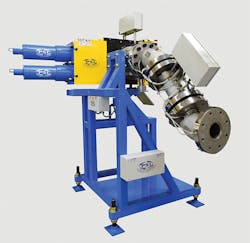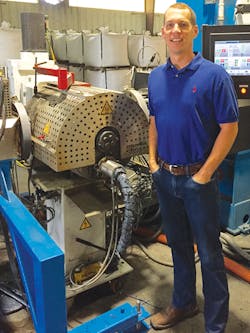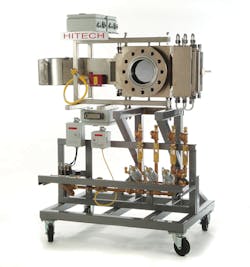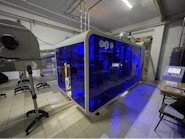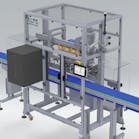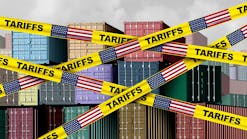Screen changers represent an active and highly competitive segment of the plastics machinery industry. Nevertheless, one source recently asserted that there hasn't been anything new in the technology for 40 years. This statement ignores an important fact: Though they are usually small with respect to the rest of the equipment in the line, screen changers serve an extremely important function. The systems collect and dispose of contaminants, both to protect the equipment in the line, and to ensure the purity of the product.
Screen changers are available through original equipment manufacturers, as well as through integrators — extrusion line designers who do not manufacture the units. Processors' challenges vary, so screen changers deliver different benefits, depending on the situation.
Integrator Gamma Meccanica North America, Greer, S.C., for example, does not manufacture screen changers, but President/GM Heath Sellers says it proposes components that it believes best fit the application. Gamma Meccanica recommends BD Plast srl, Bondeno, Italy, for hydraulic slide-plate units; Nordson Corp., Westlake, Ohio, for its high-end continuous back-flush systems; and Ettlinger North America LP, Tyrone, Ga., for its rotary drum for heavy contamination. Similarly, ADG Solutions, Fairfield, Conn., an integrator specializing in recycling, makes recommendations from among various brands of screen changers.
A number of manufacturers, including High-Technology Corp., Hackensack N.J.; Ettlinger Kunststoffmaschinen GmbH, KÓ§nigsbrunn, Germany; Berlyn ECM Inc., Worcester, Mass.; and PSI-Polymer Systems Inc., Conover, N.C., have found innovative solutions to the challenges facing processors.
High-Technology Corp., which supplies continuous, ribbon-style screen changers that are characterized by constant melt temperature and pressure at the die, cited the successful use of its equipment in a flexible PVC precision tubing plant, which has since retrofitted all its equipment.
Until recently, successful filtration of flexible PVC posed a challenge, given the thermally unstable characteristics of the material. In addition, the low melt temperature and corresponding high viscosity of the polymer have created unique processing challenges that have limited the feasibility of successful filtration.
For High-Technology's customer, a manufacturer in the Midwest, Hitech-brand equipment has overcome these challenges.
High-Technology's newest generation of sophisticated programmable logic controllers (PLCs) makes it possible to adapt to various pressure conditions. Operational parameters are continuously monitored, and using a new algorithm, the technology is able to maintain pressure and temperature, so that it can handle thermally unstable polymers. This had not been possible with earlier designs, which limited the implementation of the continuous ribbon-type technology with flexible PVC.
The success of this application has been further supported by recent design innovations. The entire screen changer is fabricated from corrosion-resistant materials to further inhibit the formation of degraded material, allowing for longer, uninterrupted production runs than the processor had previously been able to attain. In addition, a new proprietary breaker plate design permits the screen to advance reliably under the high differential pressure conditions that are generated by flexible PVC. This new design also minimizes the formation of degraded material behind the plate, another concern when processing thermally unstable polymers. This has enabled High-Technology's customer to introduce significant amounts of regrind into the product.
At Ettlinger North America, Managing Director Mike Diletti cites examples of processors that have switched to Ettlinger ERF continuous drum melt filters from slide-plate or back-flush screen changers or even continuous flat-screen units. The ERF makes use of a continuously rotating filter screen that is cleaned automatically several times per minute. If contamination increases, the filter drum automatically speeds up to handle it. Diletti notes that processors range from those recycling in-house materials to independent recyclers buying post-consumer or post-industrial materials and producing valuable pelletized materials.
A number of recyclers have adopted the ERF screens. Proponents include Bryan Adams, operations manager for Somerset Recycling Services Inc., Somerset, Ky.; President Alan Shaw of Plastic Recycling Inc. (PRI), Indianapolis; and Claudine Osipow, president and CEO of DCO Environmental & Recycling LLC, San Francisco.
Adams says the Ettlinger product helped reduce downtime significantly at his company. He says the ERF250 improves PP and virtually eliminates pelletizer downtime since the screen does not have the pressure swings of the previously used slide plate. The input material can go from being relatively clean to highly contaminated with paper and cardboard, without problems, because the screen changer is flexible enough to handle a range of contamination levels.
PRI's Shaw reports that its screening equipment could no longer handle the levels of contamination and variability in incoming materials. The company, which recycles PS, PP and PE, tried back flush, but decided the ERF would perform better. It was important to PRI that it could process materials with impurity levels of as much as 5 percent from contaminants such as paper, foil and PET. Folded, frayed or broken screen packs are now a thing of the past.
DCO's Osipow says Ettlinger's ERF 250 continuous melt filter has helped the company cope with a variety of material streams.
To reduce downtime at its plant in the Eastern U.S., a fluoropolymer compounder started using a 20-inch, 35,000-pound Berlyn BCM-20M slide-plate screen changer. In the two years the bore hydraulic screen changer has been in service, the compounder has made hundreds of screen changes, each with a push of a button and without stopping production. The screen changer's design allows high-speed screen changes with minimal process interruption via a heavy-duty hydraulic system. Prior to installation of the unit, the compounder had to shut down the extrusion line for four hours or more to change the filter.
Proprietary metallurgy and alloy application are key to the success of the equipment, which allows leak-free operation and prevents corrosion and subsequent material contamination. The low-pressure-drop design is specifically suited for fluoropolymer processes. The alloy technology allows the screen changer to handle the extreme temperatures and corrosive conditions inherent with fluoropolymer extrusion. The screen changer is designed to eliminate the use of a fixed breaker plate and candle-filter systems for filtration. In addition to dramatic improvements in the filtration and screen changing functions, the compounder cites benefits in improved worker safety.
Greater efficiency is one of the benefits that a West Coast processor realized after it contacted PSI to review its underperforming, 30-year-old extrusion line. PSI immediately noticed that the setup was not ideal for the co-extruded sheet application that the processor was running. The line's existing hydraulic screen changers and melt pumps both leaked, and the old melt pump's internal components had become worn and inefficient. This resulted in more revolutions per minute and higher shear, which in turn impacted both the gauge control and the line's cooling capacity. The screen changer's single, on-line filter design limited the amount of reclaimed material that could be used, resulting in a higher cost of goods than was competitively feasible. In addition, the equipment included a black, cast-iron pipe that was nearly impossible to clean, and the feed block was located an unusually long distance from the die.
Working with the processor, PSI was able to identify several changes to meet the plant's objectives for higher output, increased use of regrind, process stability and improved product quality. To accomplish this, the pipes and post-extruder equipment up to, but not including, the die were replaced.
Stainless steel pipe was designed to be disassembled in sections so it could be easily separated and cleaned. The main slide-plate hydraulic screen changer was replaced with a continuous model to stabilize pressure changes, eliminate downtime for screen changes and allow the process to run up to 95 percent regrind. The gear pumps were replaced, which brought pump efficiency to 99 percent, stabilized the die pressure and reduced melt temperature. Lastly, to limit residence time and improve layering, PSI partnered with Allied Dies Inc., Chippewa Falls, Wis., to mate a new feed block to the existing die block.
In another instance two years ago, PSI helped an HDPE corrugated pipe manufacturer in the Northeastern U.S. that was having issues running its indexing roll screen changer. Because it was a fractional melt application, the material stiffness and resulting high pressure created a large amount of resistance to the moving screen. This frequently caused the screen to dimple into the breaker plate, get stuck and tear. The customer had given up on using screens altogether because it was inefficient to keep rethreading the torn screen. This caused the quality of the end product to suffer and raised the product cost because the process could not run regrind material.
To fix the problem, PSI replaced the indexing screen changer with a dual-bolt continuous design. This type of screen changer splits the melt flow into two (or four) melt channels, each feeding an online screen pack. The dual-bolt design holds the screen packs stationary in recessed pockets. During a screen change, the screens are held in place by the pressure and volume of the melt and remain in place until exiting the housing for replacement. Shifting one screen offline simply diverts the polymer flow through a remaining online screen to maintain uninterrupted output. After installing the dual-bolt design, and thus achieving true continuous operation, the processor was able to run a much higher filtration level and add a sizable percentage of regrind to reduce product cost. Payback time of the screen changer cost was less than one year.
PSI was also able to assist a processor running HIPS heavy-gauge prefabricated sheet products in the Southeastern U.S. The line had been fitted with a hydraulic slide-plate screen changer with a gear pump downstream. Every time that a screen change was necessary, anywhere from 29 to 87 times a day at the time, it generated scrap. As business grew, the company overtaxed its line to double its rate of production, increasing its waste to between 50 and 80 feet during a screen change. This amount of waste was unacceptable. Further, post-industrial scrap was piling up in trailers and could not be used because of high contamination.
Called in to evaluate the situation, PSI proposed a back-flush continuous screen changer to replace the slide plate. The back flush automatically self-cleans and reuses the screens in a continuous production process, which has eliminated the frequent line breaks caused each time the discontinuous slide plate was shifted to change a screen. Where the slide plate offered only a single screen pack online, the back flush uses four streams simultaneously. That way, when a screen change is necessary, the operator can do it while three streams are flowing. This immediately eliminated scrap produced during screen changes, while also allowing the processor to double the line's speed, as well as its output.
Back flushing the screens led to a drop in screen changes from 29 on a good day to just three. Additionally, unlike a slide plate, a back-flush screen changer needs no operator for cleaning. It is controlled by a PLC, which allows one operator to run up to three lines instead of just one.
The drop in screen changes alone would have allowed the company to see a return on its investment quickly, but with the dramatic elimination of scrap, the added utilization of low-cost, post-consumer scrap and the savings in operator time, it reached full return on investment in less than eight months.
Merle R. Snyder, senior correspondent
msnyder@plasticsmachinerymagazine.com
Contact:
ADG Solutions, 203-255-9444, www.adgs.net
Allied Dies Inc., 715-720-1872, www.allied-dies.com
BD Plast srl, 39-0532-88-88-11, www.bdplast.com
Berlyn ECM Inc., 508-852-0040, www.berlynecm.com
Ettlinger North America LP, 630-596-7449, www.ettlinger.com
Gamma Meccanica North America, 864-675-0775, www.irecyclingsolutions.com
High-Technology Corp., 201-488-0010, www.screenchanger.com
Nordson Corp., 770-339-4177, www.nordson-k.com
PSI-Polymer Systems Inc., 828-468-2600, www.psi-polymersystems.com

